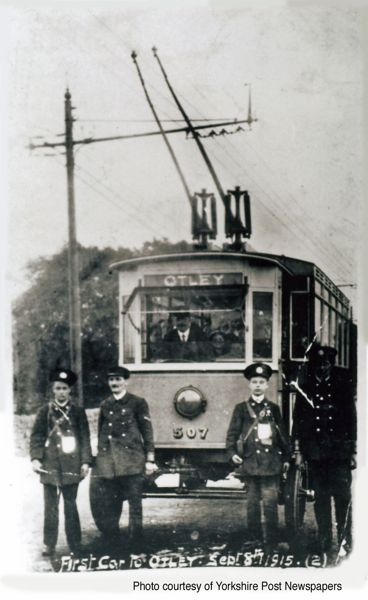September the 8th will mark the 94th anniversary of the introduction by Leeds Corporation in 1915 of a trolleybus system between Guiseley and Otley. To remind us of the event, here is a photograph of one of the trolleybuses that ran on the route and an account of the inauguration from the Yorkshire Post of the 9th September 1915.
WHAREFEDALE TRACKLESS TRAMS
OPENING OF THE LEEDS CORPORATION EXTENSION TO OTLEY
The official opening of the new trackless tram route from Guiseley to Otley took place yesterday afternoon. The new route covers a length of three miles, to beyond the centre of the town of Otley, but there is still to complete a mile and a half from the junction at Menston to Burley. It is hoped to have this completed by the end of September. At present it is hoped to institute a forty minutes service during the morning and a twenty minutes service during the afternoon. On Sundays, a twenty minute service will begin about mid-day. These services are only temporary, and will be varied as experience shows the requirements of the district. For some time too, the timetable is bound to be restricted, on account of the scarcity of labour. The provision of a workman’s service in the early morning will also be considered. The fare from Otley to Oxford Road, Guiseley (thus including the recent extension to the rail-car) will be 3d, or from Otley to the centre of Leeds 3d, and the time occupied in the journey will be about an hour and a quarter.
Among those present in the “opening car” were Councillors J S Hinchliffe, Chairman of the Leeds City Tramways Committee, G H Pearson, Alf. Masser, and C G Gibson (members of the Tramways Committee) together with Councillors N G Morrison and T Winn. Mr J B Hamilton, the General Manager was also present along with other officials and Mr E Priestley, the Chairman of the Bradford City Tramways Committee. On arrival at the Otley boundary, several members of the Otley District Council boarded the car, among them being the Chairman (Mr Harold Duncan) and the Clerk (Mr C F Atkinson).
All through the town the streets were lined with spectators, and a rousing reception was given at the terminus at Maypole Square. Here, Mr Harold Duncan spoke from the car, welcoming the service in the name of the council and the townspeople, and at the conclusion of his speech, three hearty cheers were accorded to the Leeds Corporation. Councillor Hinchliffe replied to the welcome, remarking that the cars marked another link binding the rural districts with the larger cities, and hoping the venture would prove an unqualified success. They should be mindful that three essentials should be observed. The first was an efficient service; the second was an appreciative public; and the third, the efficient maintenance of the roads over which the cars would travel. In the present strenuous times there might have been cause to complain that local authorities were unable to spend on the maintenance of the roads the money the roads deserved, but all such complaints would, it was hoped, be remedied when peace was restored.
The company then adjourned to the Manor Club where refreshments were served, and a little further speech-making took place. Mr Harold Duncan said the Otley Council had always been in favour of the extension, believing it to be in the best interests of the townspeople. There had been various rumours that these extensions were only a prelude to the big cities swallowing up the smaller places, but Otley was not frightened of this happening.
Mr Hinchliffe said the time had gone by when big cities would create a monopoly for themselves and refuse the privileges they enjoyed to the smaller places outside. It had been the object of Leeds to make their tramway system mutually beneficial.
Mr Priestley also spoke, mentioning that in Bradford they were looking forward to an extension of their tram service to link up with the Leeds system in Guiseley.

